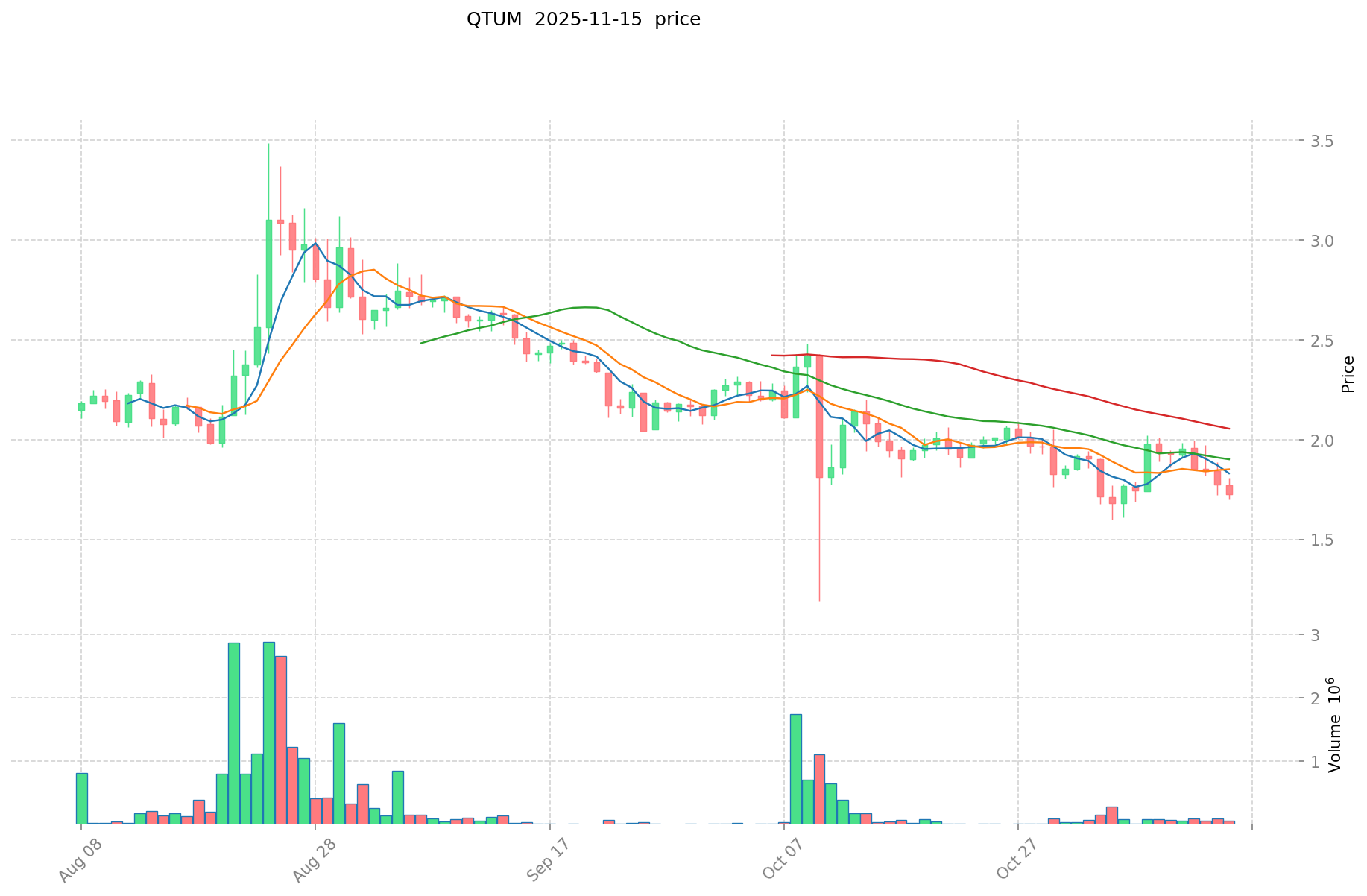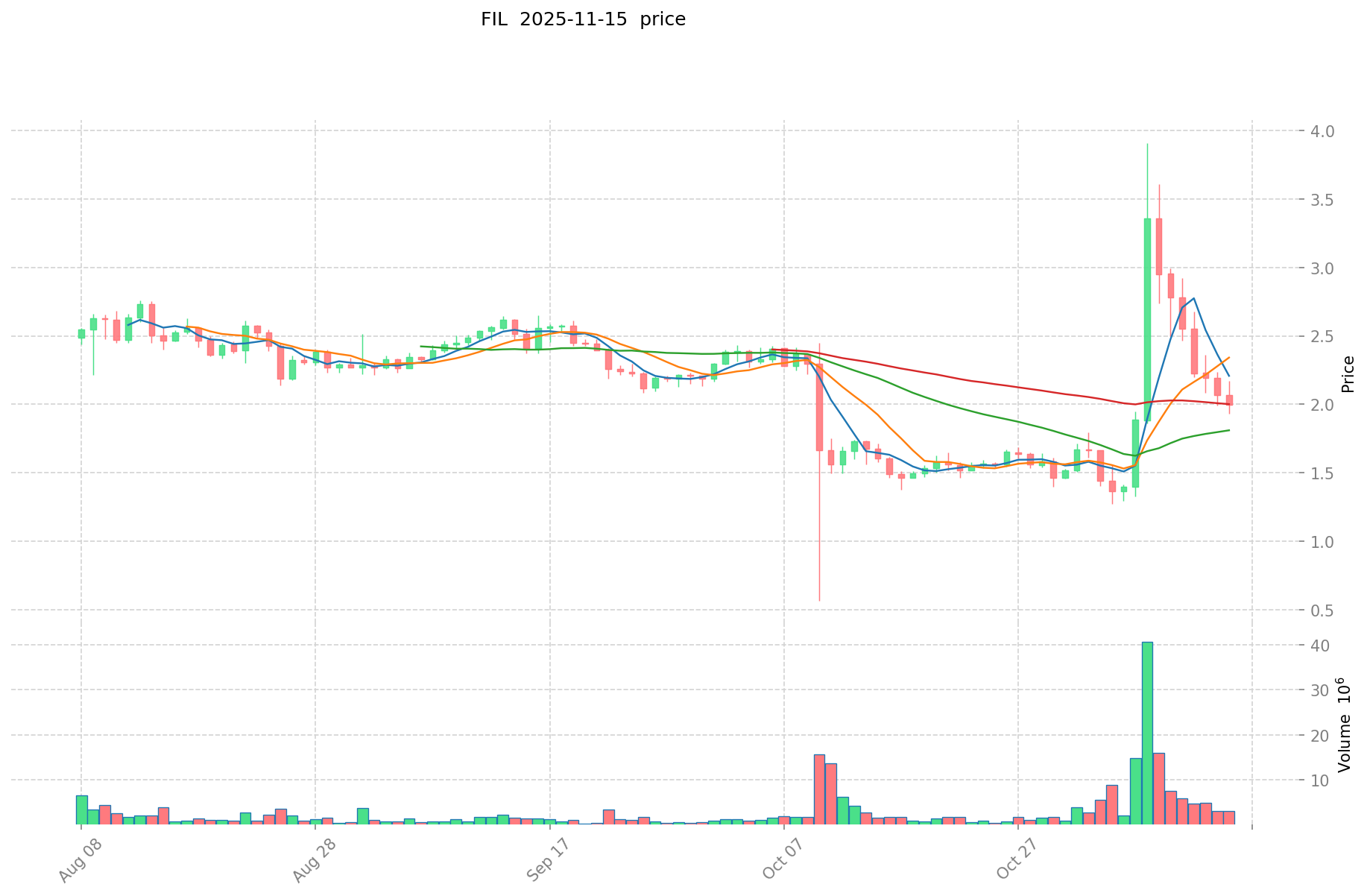QTUM vs FIL: A Comparative Analysis of Two Innovative Blockchain Platforms
Introduction: QTUM vs FIL Investment Comparison
In the cryptocurrency market, the comparison between QTUM and FIL has always been an unavoidable topic for investors. The two not only show significant differences in market cap ranking, application scenarios, and price performance, but also represent different crypto asset positioning.
QTUM (QTUM): Since its launch in 2017, it has gained market recognition for its aim to develop a third blockchain ecosystem beyond Bitcoin and Ethereum.
FIL (FIL): Since its introduction in 2020, it has been hailed as a decentralized storage network, rewarding miners for contributing idle hard disk space.
This article will comprehensively analyze the investment value comparison between QTUM and FIL, focusing on historical price trends, supply mechanisms, institutional adoption, technical ecosystems, and future predictions, attempting to answer the question investors care about most:
"Which is the better buy right now?"
I. Price History Comparison and Current Market Status
QTUM and FIL Historical Price Trends
- 2018: QTUM reached its all-time high of $100.22 on January 6, 2018.
- 2021: FIL hit its all-time high of $236.84 on April 1, 2021, likely due to increased interest in decentralized storage solutions.
- Comparative analysis: During their respective market cycles, QTUM dropped from its high of $100.22 to a low of $0.783142, while FIL declined from $236.84 to $0.848008.
Current Market Situation (2025-11-16)
- QTUM current price: $1.758
- FIL current price: $2.095
- 24-hour trading volume: QTUM $94,362.72 vs FIL $6,233,536.82
- Market Sentiment Index (Fear & Greed Index): 10 (Extreme Fear)
Click to view real-time prices:
- View QTUM current price Market Price
- View FIL current price Market Price


II. Core Factors Affecting Investment Value of QTUM vs FIL
Supply Mechanism Comparison (Tokenomics)
- QTUM: Fixed maximum supply of 107,822,406 QTUM
- FIL: Inflationary model with a maximum cap of 2 billion FIL, featuring block rewards that decrease over time
- 📌 Historical Pattern: QTUM's fixed supply creates scarcity while FIL's gradual emission schedule aims to balance network growth and value preservation.
Institutional Adoption and Market Applications
- Institutional Holdings: Filecoin has gained more institutional traction with storage providers and Web3 infrastructure companies
- Enterprise Adoption: Filecoin has established partnerships with Protocol Labs ecosystem while QTUM focuses on enterprise blockchain applications in Asia
- National Policies: Both face varied regulatory approaches across jurisdictions, with Filecoin gaining recognition as decentralized storage infrastructure
Technical Development and Ecosystem Building
- QTUM Technical Upgrades: Combines Bitcoin's UTXO model with Ethereum's VM for enhanced security and smart contract functionality
- FIL Technical Development: Focus on decentralized storage network with recent enhancements to storage proofs and retrieval efficiency
- Ecosystem Comparison: QTUM excels in DeFi and enterprise applications in Asian markets, while FIL has established stronger positioning in decentralized storage infrastructure and data services
Macroeconomic Factors and Market Cycles
- Performance in Inflationary Environments: QTUM's fixed supply potentially offers better inflation hedge characteristics
- Macroeconomic Monetary Policy: Both affected by broader crypto market trends related to interest rates and dollar strength
- Geopolitical Factors: FIL's decentralized storage value proposition may provide utility during data sovereignty concerns
III. 2025-2030 Price Prediction: QTUM vs FIL
Short-term Prediction (2025)
- QTUM: Conservative $1.21 - $1.76 | Optimistic $1.76 - $2.14
- FIL: Conservative $1.40 - $2.09 | Optimistic $2.09 - $2.91
Mid-term Prediction (2027)
- QTUM may enter a growth phase, with estimated prices $1.97 - $2.16
- FIL may enter a bullish market, with estimated prices $1.85 - $3.39
- Key drivers: Institutional capital inflow, ETF, ecosystem development
Long-term Prediction (2030)
- QTUM: Base scenario $2.49 - $2.87 | Optimistic scenario $2.87 - $3.04
- FIL: Base scenario $2.49 - $3.95 | Optimistic scenario $3.95 - $4.10
Disclaimer: This analysis is for informational purposes only and should not be considered as financial advice. Cryptocurrency markets are highly volatile and unpredictable. Always conduct your own research before making any investment decisions.
QTUM:
| 年份 | 预测最高价 | 预测平均价格 | 预测最低价 | 涨跌幅 |
|---|---|---|---|---|
| 2025 | 2.142686 | 1.7563 | 1.211847 | 0 |
| 2026 | 2.24191695 | 1.949493 | 1.3646451 | 10 |
| 2027 | 2.15857612425 | 2.095704975 | 1.9699626765 | 19 |
| 2028 | 2.55256865955 | 2.127140549625 | 1.446455573745 | 20 |
| 2029 | 3.392789176651875 | 2.3398546045875 | 1.520905492981875 | 33 |
| 2030 | 3.038301204056868 | 2.866321890619687 | 2.493700044839128 | 63 |
FIL:
| 年份 | 预测最高价 | 预测平均价格 | 预测最低价 | 涨跌幅 |
|---|---|---|---|---|
| 2025 | 2.90927 | 2.093 | 1.40231 | 0 |
| 2026 | 3.2014528 | 2.501135 | 1.500681 | 19 |
| 2027 | 3.393039741 | 2.8512939 | 1.853341035 | 36 |
| 2028 | 3.652935179985 | 3.1221668205 | 2.091851769735 | 49 |
| 2029 | 4.505442830322525 | 3.3875510002425 | 3.150422430225525 | 61 |
| 2030 | 4.104356791893813 | 3.946496915282512 | 2.486293056627982 | 88 |
IV. Investment Strategy Comparison: QTUM vs FIL
Long-term vs Short-term Investment Strategy
- QTUM: Suitable for investors focused on enterprise blockchain applications and Asian market potential
- FIL: Suitable for investors interested in decentralized storage solutions and Web3 infrastructure
Risk Management and Asset Allocation
- Conservative investors: QTUM: 30% vs FIL: 70%
- Aggressive investors: QTUM: 60% vs FIL: 40%
- Hedging tools: Stablecoin allocation, options, cross-currency portfolios
V. Potential Risk Comparison
Market Risk
- QTUM: Volatility due to smaller market cap and lower trading volume
- FIL: Susceptibility to fluctuations in demand for decentralized storage
Technical Risk
- QTUM: Scalability, network stability
- FIL: Mining power concentration, security vulnerabilities
Regulatory Risk
- Global regulatory policies may affect both differently, with FIL potentially facing more scrutiny as a decentralized storage solution
VI. Conclusion: Which Is the Better Buy?
📌 Investment Value Summary:
- QTUM advantages: Fixed supply, enterprise blockchain focus in Asian markets
- FIL advantages: Strong positioning in decentralized storage, institutional adoption
✅ Investment Advice:
- New investors: Consider a balanced approach with a slight preference for FIL due to its larger ecosystem
- Experienced investors: Explore opportunities in both, with a focus on QTUM's potential in Asian markets
- Institutional investors: Consider FIL for its decentralized storage infrastructure potential
⚠️ Risk Warning: Cryptocurrency markets are highly volatile. This article does not constitute investment advice. None
VII. FAQ
Q1: What are the main differences between QTUM and FIL? A: QTUM focuses on enterprise blockchain applications, particularly in Asian markets, with a fixed supply of tokens. FIL is a decentralized storage network with an inflationary token model and stronger institutional adoption in the Web3 infrastructure space.
Q2: Which cryptocurrency has shown better price performance historically? A: FIL reached a higher all-time high of $236.84 in April 2021, compared to QTUM's all-time high of $100.22 in January 2018. However, both have experienced significant price declines since their peaks.
Q3: How do the supply mechanisms of QTUM and FIL differ? A: QTUM has a fixed maximum supply of 107,822,406 tokens, creating scarcity. FIL has an inflationary model with a maximum cap of 2 billion tokens, featuring block rewards that decrease over time to balance network growth and value preservation.
Q4: Which cryptocurrency is better suited for long-term investment? A: This depends on individual investment goals. QTUM may be suitable for those interested in enterprise blockchain applications and Asian market potential, while FIL might appeal to investors focused on decentralized storage solutions and Web3 infrastructure.
Q5: What are the key risks associated with investing in QTUM and FIL? A: Both face market risks due to volatility. QTUM has technical risks related to scalability and network stability, while FIL faces risks of mining power concentration and potential security vulnerabilities. Both are subject to regulatory risks, with FIL potentially facing more scrutiny as a decentralized storage solution.
Q6: How do the price predictions for QTUM and FIL compare for 2030? A: For 2030, QTUM's base scenario predicts a range of $2.49 - $2.87, with an optimistic scenario of $2.87 - $3.04. FIL's base scenario for 2030 is $2.49 - $3.95, with an optimistic scenario of $3.95 - $4.10.
Q7: What factors should be considered when deciding between QTUM and FIL for investment? A: Investors should consider factors such as market capitalization, trading volume, institutional adoption, technical development, ecosystem growth, and alignment with their investment strategy. QTUM's strengths lie in its fixed supply and focus on enterprise applications in Asia, while FIL benefits from its strong positioning in decentralized storage and broader institutional adoption.
Share
Content